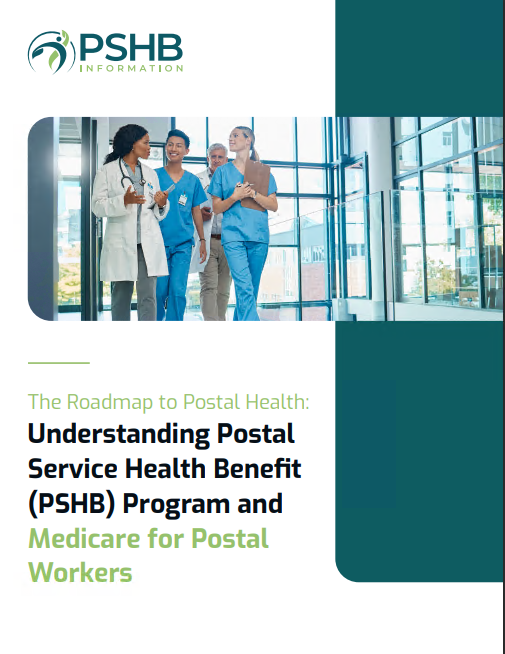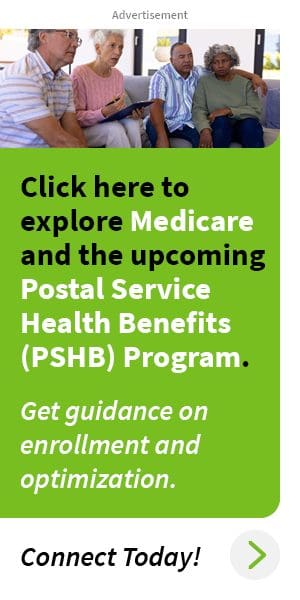Key Takeaways
-
Open Season for the Postal Service Health Benefits (PSHB) program runs from November 11 to December 9, 2024. Now is the time to review, choose, and make changes to your health plan options for 2025.
-
Some Medicare-eligible retirees and family members may need to enroll in Medicare Part B to keep PSHB coverage, but exceptions apply based on retirement dates and enrollment status.
PSHB Open Season: What’s New for Postal Workers?
With Open Season around the corner, it’s time to think about your health coverage for the new year. This Open Season is unique for Postal Service employees, retirees, and family members transitioning to the Postal Service Health Benefits (PSHB) program—a new system tailored just for us. Let’s walk through what’s changing, what you’ll need to know, and how to get the most out of Open Season this year.
PSHB: Why This Open Season Is Important
Starting in 2025, the PSHB program will replace the previous Federal Employees Health Benefits (FEHB) coverage for postal workers, retirees, and eligible family members. Open Season is your annual chance to review, adjust, or change your health plan choices to meet your needs for the coming year.
Some quick reminders:
- Open Season Dates: November 11 – December 9, 2024.
- Changes Effective Date: January 1, 2025.
For current FEHB enrollees, don’t worry—you’ll be automatically transferred into a corresponding PSHB plan if you don’t actively make a change. However, checking the details of your new PSHB plan is still essential to make sure it meets your needs.
PSHB and Medicare Part B: Do You Need It?
A major change in the PSHB program is the requirement for certain Medicare-eligible annuitants and family members to enroll in Medicare Part B. This requirement ensures your PSHB benefits remain in place, but there are key exceptions:
- Who Must Enroll:
- Medicare-eligible Postal Service retirees or Medicare-eligible family members must enroll in Part B to retain PSHB coverage.
- Exceptions:
- If you retired on or before January 1, 2025, and aren’t already enrolled in Part B, you’re not required to sign up for it to maintain your PSHB coverage.
This Medicare requirement is designed to help integrate your PSHB and Medicare benefits, ensuring comprehensive health coverage without gaps.
Choosing the Right Plan: Factors to Consider
When it comes to picking a plan, there are a few factors to keep in mind:
1. Your Health Needs
- Think about your and your family’s health requirements, including any regular medications, planned procedures, or special health needs.
- Plans vary in their coverage, with some focusing more on preventive services and others emphasizing coverage for specialists and procedures.
2. Provider Networks
- The PSHB plans will each have their network of providers. If you have preferred doctors or specialists, check to make sure they’re included in the network for the plan you’re considering.
- In-network providers are essential for keeping your costs down, as you’ll often pay less for in-network services than for out-of-network providers.
3. Premiums and Cost-Sharing
- While automatic enrollment means you won’t lose coverage, it’s important to compare plan options to see if another choice might better balance premiums and out-of-pocket costs.
- For families, consider the cost-sharing policies for dependents to avoid surprises with copays or deductibles.
Types of Plans Available in PSHB
Under the PSHB program, there’s a range of plan types available, giving you some flexibility to find what best fits your situation. Here’s a quick breakdown of the options you’ll likely see:
1. Health Maintenance Organizations (HMOs)
- Overview: Typically offer lower premiums and require using a network of specific providers.
- Ideal For: Those who prefer lower out-of-pocket costs and are comfortable with a more structured network.
2. Preferred Provider Organizations (PPOs)
- Overview: Offer more flexibility, including out-of-network coverage, but usually come with higher premiums.
- Ideal For: Those wanting more choice in their healthcare providers and willing to pay a bit more for the flexibility.
3. High-Deductible Health Plans (HDHPs)
- Overview: Have lower monthly premiums but higher deductibles, making them suitable for those who don’t expect high medical costs.
- Ideal For: Those in good health who don’t anticipate frequent medical visits and want to keep monthly costs low.
4. Consumer-Driven Health Plans (CDHPs)
- Overview: Plans with a higher deductible paired with a Health Reimbursement Arrangement (HRA) that helps offset some of your costs.
- Ideal For: People comfortable managing their healthcare spending and looking for a balance between premium costs and potential out-of-pocket expenses.
Why Automatic Enrollment Matters
If you’re already enrolled in FEHB, you’ll automatically move to a corresponding PSHB plan for 2025. You’ll be notified in advance about which plan you’ll transition to. Still, it’s a good idea to actively review your options during Open Season to make sure your new PSHB plan truly fits your needs.
Advantages of Automatic Enrollment
- Continuous Coverage: You won’t have to worry about any lapses in coverage.
- Easy Transition: Automatic enrollment ensures that the switch to PSHB is smooth.
However, it’s always a good move to check your plan options and make any needed adjustments during Open Season.
Steps to Review and Select a PSHB Plan
Let’s break down a step-by-step guide on how to approach Open Season:
1. Mark Your Calendar
- Remember, Open Season runs from November 11 to December 9, 2024. Set a reminder to check out your options during this window.
2. Review Your Current Benefits and Health Needs
- Assess how well your current plan is meeting your needs. Are there services or benefits you wish were covered differently? Use this assessment to identify what you want in your PSHB plan.
3. Check the Plan Comparison Tool
- The PSHB offers a plan comparison tool on the Office of Personnel Management’s website. This tool lets you compare plan options side by side, giving you a clear picture of costs, covered services, and provider networks.
4. Explore the Medicare Requirements
- If you or a family member is Medicare-eligible, make sure you understand any enrollment requirements to maintain PSHB coverage. Remember that enrolling in Medicare Part B might be necessary unless you meet the exceptions.
5. Consult Your Plan’s Customer Service
- For any questions about specifics like covered providers or out-of-pocket costs, reach out to the customer service line of the plan you’re considering.
6. Make Your Choice
- Once you’ve reviewed everything, go ahead and make your selection by the December 9 deadline.
What to Expect for 2025
With PSHB starting in 2025, we can anticipate a few changes compared to traditional FEHB. For one, these plans are specifically designed with postal workers in mind. Expect options that reflect the needs of both active and retired postal workers, as well as adjustments to account for Medicare integration for those eligible.
Plan costs may vary, and while PSHB plans will continue to offer robust health coverage, you might see differences in premiums, provider networks, and benefit details compared to past FEHB options.
How to Make the Most Out of Open Season
Here’s how to approach Open Season to feel confident in your choice:
-
Actively Review: Don’t rely solely on automatic enrollment; take time to see if other options fit your needs better.
-
Look Beyond Premiums: Consider the whole cost picture, including deductibles, copays, and out-of-pocket maximums.
-
Factor in Medicare: If you or a family member is Medicare-eligible, ensure your PSHB selection aligns with Part B requirements.
-
Confirm Coverage for Family: If you have dependents, confirm that your selected plan offers the family coverage you need.
Ready for Open Season?
With PSHB Open Season fast approaching, this is your chance to review your health plan for 2025. Consider your unique health needs, your family’s situation, and any Medicare eligibility requirements to make the best decision. And remember, with automatic enrollment, you won’t lose coverage if you don’t make a change, but it’s worth the time to ensure the best fit for your health needs.






